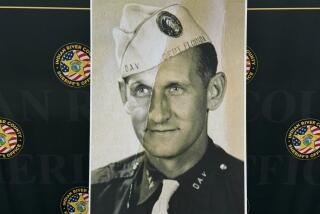Paul Royle dies at 101; one of the last “Great Escape” survivors
Paul Royle, an Australian pilot who took part in a mass breakout from a German prisoner of war camp during World War II that is remembered as the Great Escape, has died in his hometown of Perth, his son said Friday. He was 101.
The escape was the subject of a 1963 movie, “The Great Escape,” starring Steve McQueen, a work of artistic license that Royle loathed.
Royle died Sunday at a Perth hospital following surgery for a hip fracture that he suffered in a fall in a nursing home three weeks ago, his son Gordon Royle said.
------------
FOR THE RECORD:
Paul Royle obituary: In the Aug. 31 California section, the obituary of Paul Royle, a member of the World War II prison camp breakout known as the Great Escape, described the three escapees who made it home as two Norwegians and a Dane. It was two Norwegians and a Dutchman. —
------------
Royle’s death leaves only one survivor among the 76 men who escaped from Stalag Luft III, located outside Berlin.
The survivors had formed an informal club and had kept in contact through a newsletter called the “Sagan Select Subway Society,” which listed the passing of each member. The latest newsletter among Paul Royle’s belongings showed he was one of the two last survivors.
Royle revealed last year, on the 70th anniversary of the tunnel escape in March 1944, that he was no fan of the Hollywood interpretation of the story.
“The movie I disliked intensely because there were no motorbikes ... and the Americans weren’t there,” he told Australian Broadcasting Corp., referring to McQueen’s dramatic bid to outrun the Germans on a motorbike.
Gordon Royle said his father was angry that Hollywood created an adventure out of soldiers doing their often tedious and dangerous duty of attempting to escape.
“He felt the movie was a glamorization of the tedium and the drabness of the actuality,” Gordon Royle said.
“The idea that they got on a motorbike and soared over a barbed wire fence is far from the reality, which was darkness and cold and terror,” he said.
Only three of the escapees made it home. Fifty others, from 12 nations, were shot dead when caught. Another 23 were sent back to the Stalag or to other camps but survived the war.
Royle said his contribution to the escape operation was to distribute dirt excavated from the 360-foot tunnel around the camp grounds. This was done by surreptitiously releasing the soil down his trouser legs in areas where the ground color vaguely matched. He spent two days hiding in a snow-covered forest before he was recaptured.
Flight Lt. Royle was a pilot in the Royal Air Force when he was shot down over France on May 17, 1940, and was captured. His two days in the freezing forest in 1944 were his only taste of freedom until he was liberated by British troops from the Marlag und Milag Nord prison camp in Germany on May 2, 1945.
Born in Perth on Jan. 17, 1914, Royle left school at 14 and worked with his engineer father surveying airfields in Australia’s sparsely populated and remote northwest outback. In 1936 he enrolled in the Western Australian School of Mines to become a mine surveyor.
He was recruited by the Royal Air Force and relocated to England in February 1939 to train as a pilot officer.
Gordon Royle said he had no idea his father had been involved in the Great Escape until he read his name in a book about the famous breakout in the mid-1970s.
“He was always looking forward. He never looked back. He wanted to focus on what was coming, not what had been,” Gordon Royle said.
The son said he found newspaper clippings and obituaries related to the escape among his father’s belongings.
“He maintained an interest but hadn’t let it define him as a person,” Gordon Royle said.
Paul Royle is survived by his second wife, their two children and a sister. He also has three children from his first marriage, eight grandchildren and two great-grandchildren.
More to Read
Start your day right
Sign up for Essential California for the L.A. Times biggest news, features and recommendations in your inbox six days a week.
You may occasionally receive promotional content from the Los Angeles Times.






